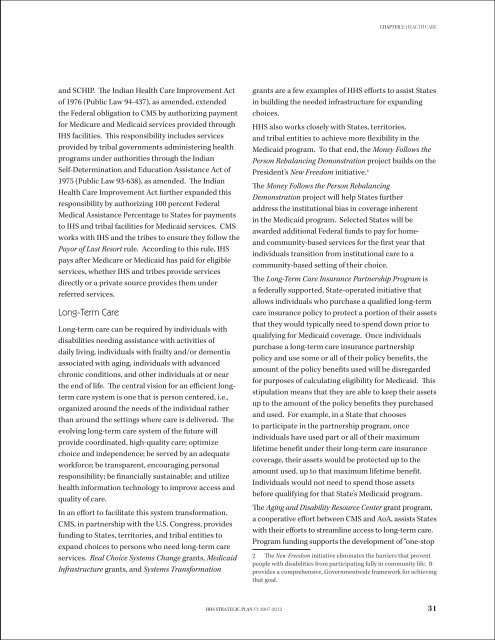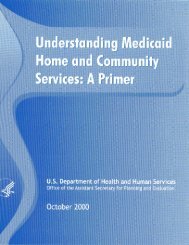STRATEGIC PLAN - ASPE - U.S. Department of Health and Human ...
STRATEGIC PLAN - ASPE - U.S. Department of Health and Human ...
STRATEGIC PLAN - ASPE - U.S. Department of Health and Human ...
Create successful ePaper yourself
Turn your PDF publications into a flip-book with our unique Google optimized e-Paper software.
CHAPTER 2: <strong>Health</strong> care<strong>and</strong> SCHIP. The Indian <strong>Health</strong> Care Improvement Act<strong>of</strong> 1976 (Public Law 94-437), as amended, extendedthe Federal obligation to CMS by authorizing paymentfor Medicare <strong>and</strong> Medicaid services provided throughIHS facilities. This responsibility includes servicesprovided by tribal governments administering healthprograms under authorities through the IndianSelf-Determination <strong>and</strong> Education Assistance Act <strong>of</strong>1975 (Public Law 93-638), as amended. The Indian<strong>Health</strong> Care Improvement Act further exp<strong>and</strong>ed thisresponsibility by authorizing 100 percent FederalMedical Assistance Percentage to States for paymentsto IHS <strong>and</strong> tribal facilities for Medicaid services. CMSworks with IHS <strong>and</strong> the tribes to ensure they follow thePayor <strong>of</strong> Last Resort rule. According to this rule, IHSpays after Medicare or Medicaid has paid for eligibleservices, whether IHS <strong>and</strong> tribes provide servicesdirectly or a private source provides them underreferred services.Long-Term CareLong-term care can be required by individuals withdisabilities needing assistance with activities <strong>of</strong>daily living, individuals with frailty <strong>and</strong>/or dementiaassociated with aging, individuals with advancedchronic conditions, <strong>and</strong> other individuals at or nearthe end <strong>of</strong> life. The central vision for an efficient longtermcare system is one that is person centered, i.e.,organized around the needs <strong>of</strong> the individual ratherthan around the settings where care is delivered. Theevolving long-term care system <strong>of</strong> the future willprovide coordinated, high-quality care; optimizechoice <strong>and</strong> independence; be served by an adequateworkforce; be transparent, encouraging personalresponsibility; be financially sustainable; <strong>and</strong> utilizehealth information technology to improve access <strong>and</strong>quality <strong>of</strong> care.In an effort to facilitate this system transformation,CMS, in partnership with the U.S. Congress, providesfunding to States, territories, <strong>and</strong> tribal entities toexp<strong>and</strong> choices to persons who need long-term careservices. Real Choice Systems Change grants, MedicaidInfrastructure grants, <strong>and</strong> Systems Transformationgrants are a few examples <strong>of</strong> HHS efforts to assist Statesin building the needed infrastructure for exp<strong>and</strong>ingchoices.HHS also works closely with States, territories,<strong>and</strong> tribal entities to achieve more flexibility in theMedicaid program. To that end, the Money Follows thePerson Rebalancing Demonstration project builds on thePresident’s New Freedom initiative. 2The Money Follows the Person RebalancingDemonstration project will help States furtheraddress the institutional bias in coverage inherentin the Medicaid program. Selected States will beawarded additional Federal funds to pay for home<strong>and</strong>community-based services for the first year thatindividuals transition from institutional care to acommunity-based setting <strong>of</strong> their choice.The Long-Term Care Insurance Partnership Program isa federally supported, State-operated initiative thatallows individuals who purchase a qualified long-termcare insurance policy to protect a portion <strong>of</strong> their assetsthat they would typically need to spend down prior toqualifying for Medicaid coverage. Once individualspurchase a long-term care insurance partnershippolicy <strong>and</strong> use some or all <strong>of</strong> their policy benefits, theamount <strong>of</strong> the policy benefits used will be disregardedfor purposes <strong>of</strong> calculating eligibility for Medicaid. Thisstipulation means that they are able to keep their assetsup to the amount <strong>of</strong> the policy benefits they purchased<strong>and</strong> used. For example, in a State that choosesto participate in the partnership program, onceindividuals have used part or all <strong>of</strong> their maximumlifetime benefit under their long-term care insurancecoverage, their assets would be protected up to theamount used, up to that maximum lifetime benefit.Individuals would not need to spend those assetsbefore qualifying for that State’s Medicaid program.The Aging <strong>and</strong> Disability Resource Center grant program,a cooperative effort between CMS <strong>and</strong> AoA, assists Stateswith their efforts to streamline access to long-term care.Program funding supports the development <strong>of</strong> “one-stop2 The New Freedom initiative eliminates the barriers that preventpeople with disabilities from participating fully in community life. Itprovides a comprehensive, Governmentwide framework for achievingthat goal.HHS Strategic Plan FY 2007-201231
















